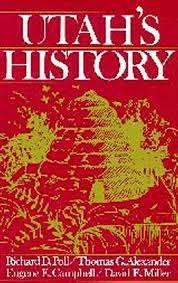Articles/Essays – Volume 13, No. 2
Utah in One Volume | Richard D. Poll, Thomas G. Alexander, Eugene E. Campbell, and David E. Miller, eds., Utah’s History
This recent publication is the best one volume history of Utah available, but it is not as good as it could or should be. The ideal volume would present a clear narrative, be integrated by sound interpretation both on individual topics and for the whole, provide adequate source references and include sufficient reading aids to facilitate effective use. The twenty-eight authors of Utah’s History, people of competence and distinction, have attempted to provide such a book. Unfortunately, their multi-authored organizational scheme seems to have prevented total success.
Utah’s History can well serve as a college level text, since the quality of the individual chapters is predominantly high, and some of its inadequacies can be overcome by a teacher. For other readers, it will likely be less useful. The book will be a helpful reference work when the subject being searched is the general topic of one of the chapters and less useful if the subject must be located through the index, which is not as thorough as it ought to be, or through reference to outside sources, since footnotes are almost nonexistent. The topics of integration and interpretation call for extended comment.
The format for integrating Utah’s History is present, but it is not fully exploited. The three major chronological divisions include excellent introductions. Each chapter is organized with an introduction, topic headings, a conclusion (usuually), a bibliography, and some references to other chapters and to attractive and serviceable maps and tables collected at the end of the volume. Unfortunately, the chapter introductions vary in their usefulness. Cross references to other chapters are all too few, and, when given, are sometimes unclear or erroneous (pp. 382, 411). References to the maps and charts are often incorrect, and in one case a lengthy list is duplicated in the text and appendix (pp. 149, 684). A list of illustrations could be valuable, and those used should be more carefully chosen to relate directly to the subjects treated in the text. The chapters in parts II and III should be reordered to collect those discussing related topics.
With regard to interpretation, Utah’s History provides some incisive views in many individual sections but fails to provide a coherent theme or themes for the work as a whole. Some argument could be made for emphasizing the relationship of Utah to the rest of the West or to the United States generally, as has been done to some extent by Charles Peterson’s recent bicentennial history, and as is suggested by several authors in this book. Some use of this perspective is one way in which the authors succeed in their attempt to “keep Utah’s History from being just another volume of Mormon history,” but they have not settled on this as their major theme nor analyzed it carefully in relationship to Mormonism in Utah.
Several authors in the early part of the book stress Mormonism as the predominant theme—”the central theme”; “make the Utah story unique in the annals of the American West”. In spite of the statement in the introduction to part III that “perhaps the most important characteristic of twentieth-century Utah has been the decline of ecclesiastical domination of policies, society, and the economy and the rise of a secular life characterized by competition,” chapters within that part include statements such as “women of Utah . . . are influenced by the doctrines and practices of the predominant church,” and “all these events . . . demonstrated how widely the policies and activities of the Mormon Church still influenced all aspects of society.” The last chapter offers an interpretive synthesis mentioning Mormonism and stressing Utah’s relationship to the other states as major themes, but while the analysis is good for the survey offered in the chapter itself, it does not take into account the contents of the entire volume.
A still needed one volume history should be prepared by a single author who will retain the information contained in Utah’s History but will reshape it into a more coherent and useable whole.
Utah’s History. Edited by Richard D. Poll, Thomas G. Alexander, Eugene E. Campbell and David E. Miller. Provo, Utah: Brigham Young University Press, 1978. 757 pp., $9.95.


 Back to full Issue
Back to full Issue

